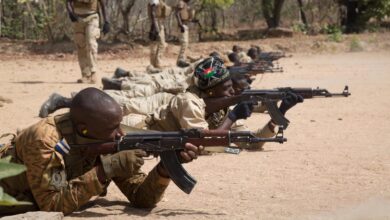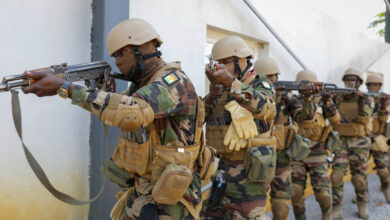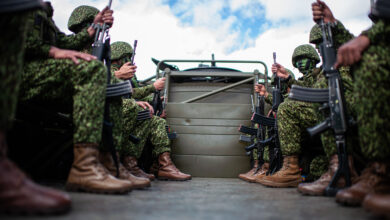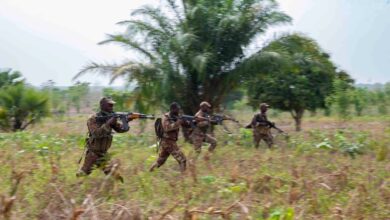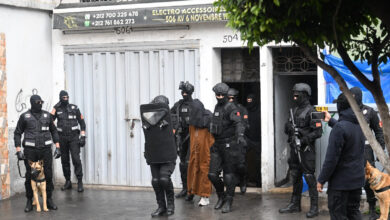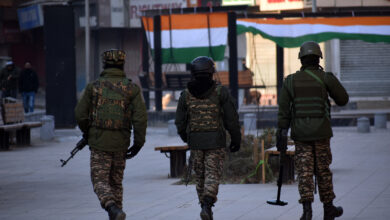One Burkina Faso gendarme was killed and another seriously injured in an attack on a security post at the Inata gold mine in the north of the country overnight on October 3, according to reports.
Unidentified assailants in at least two vehicles as well as on motorcycles attacked the mine over several hours and were eventually repelled, Infowakat reported. Five mine vehicles were later found damaged.
The AIB news agency also reported that one gendarme was killed and another was seriously injured.
The Ministry of Security later said in a statement that a detachment of the National Gendarmerie based in Inata was the target of “a large-scale attack perpetrated by a large group of heavily armed terrorists.”
The gendarmes “caused the enemies enormous losses,” the statement said, confirming that one gendarme was killed and another wounded in the leg.
#BurkinaFaso: Vehicles burned following last night's attack against the gendarmerie/Inata Gold Mine, #Soum Province (photos via @infowakat) pic.twitter.com/9WBsSrxR1f
— MENASTREAM (@MENASTREAM) October 4, 2018
According to Infowakat, aircraft from France’s Operation Barkhane mission provided air support.
Update October 4 The French armed forces ministry in a statement said that, after a request from Burkina Faso’s military authorities, aircraft deployed to operation Barkhane intervened in Inata.
A Reaper drone was sent to the area, while two Mirage 2000s and a C-135 tanker aircraft took off at short notice from the Niamey airbase and flew to the area of the attack, the statement said.
The Reaper detected a group of motorcycles leaving the area and heading north.
“After observing the behavior of the group and eliminating doubt about its terrorist nature, an air strike was carried out at night by the two Mirage 2000s,” the statement said, adding that the result of the strike is being evaluated.
Update October 5 The General Staff of the Armed Forces in an October 4 statement acknowledged the French intervention.
“Prompt reaction of the gendarmes, and the air support sent immediately to the scene by the Barkhane Force have neutralized a dozen terrorists and destroyed ten (10) motorcycles,” it said.
Inata is about 60 km (35 miles) from Djibo, the provincial capital of Soum province, which has seen a number of attacks in recent weeks.
On September 23, three mine workers, a Burkinabe national, a South African, and an Indian who is reportedly the son of the man who owns the Inata mine, were kidnapped by armed men between Djibo and the mine. Three police officers were later killed during the search for the kidnapped mineworkers.
Kisal, an NGO that promotes human rights in Africa’s Sahel region, said in a Facebook post that more than a dozen people were shot dead by members of the security forces on September 23 in Petegoli, also in Soum province.
On September 26, at least eight members of the Burkina Faso security forces were killed when a roadside bomb hit their patrol vehicle on the road between Djibo and Baraboulé.
In August, five police officers and a civilian were killed in a bomb and gun attack near the Boungou gold mine in Burkina Faso’s east.
One of the poorest countries in the world, Burkina Faso has been battling an escalating wave of attacks over the last three years, beginning with cross-border incursions in the north of the country but now spreading to the east, near the border with Togo, Benin and Niger.
Security forces have carried out a series of arrests in recent months, detaining hundreds of people in connection with the attacks.
President Roch Marc Christian Kabore said last month that additional security measures would shortly be unveiled to “resume the initiative” throughout Burkina Faso “to eradicate the curse of terrorism,” particularly in the east and north.
But a recent surge in attacks in the east of the country is said by experts to be the result of pressure on jihadist insurgents in neighboring Mali and Niger.
Elsewhere on Thursday, a Burkina Faso Defense and Security Forces vehicle was struck by a roadside bomb near Gayeri in the east near the border with Niger, killing at least five soldiers and injuring another, according to reports.
G5 Sahel Joint Force commander announces operational planning to begin
Meanwhile on October 2, Mauritanian General Hanena Ould Sidi, the new commander of the G5 Sahel Joint Force, accompanied by the chief of Staff of Burkina Faso’s armed forces announced that the “planning of operations that will take place shortly” with a view to “neutralize terrorists.”
Hanena Ould Sidi will move the G5 Sahel Joint Force headquarters to Mali’s capital Bamako after a June 29 suicide bomb and gun attack destroyed the previous HQ in Sevare, killing two soldiers and a civilian. The attack was reportedly claimed by an official from the Support Group for Islam and Muslims (JNIM), which is linked to al-Qaeda.
Justifying the transfer of the headquarters to Bamako, the general said a headquarters must be the best place to “think, plan, conduct and coordinate operations,” Burkina Faso’s ministry of defense said in a release, adding that Hanena Ould Sidi said that strong action will be taken against terrorism.
The European Union said in July that it would finance the construction of a new headquarters for the G5 Sahel Joint Force in Mali.
The G5 Sahel, comprised of Burkina Faso, Chad, Mali, Mauritania and Niger, was launched in 2014 to improve cooperation on development and security in West Africa.
They launched the G5 Sahel joint counter-terrorism force in July 2017 with a mandate to combat terrorism, transnational organized crime and human trafficking in the Sahel area.
It is set to expand to 5,000 troops, divided into seven battalions: two each from the Mali and Niger, and one from Chad, Burkina Faso and Mauritania. They will deploy along the southern edge of the Sahara desert to work alongside thousands of troops deployed to France’s Operation Barkhane in the wider Sahel and the U.N.’s Minusma peacekeeping mission in Mali.
This post was updated multiple times on October 4 and 5



